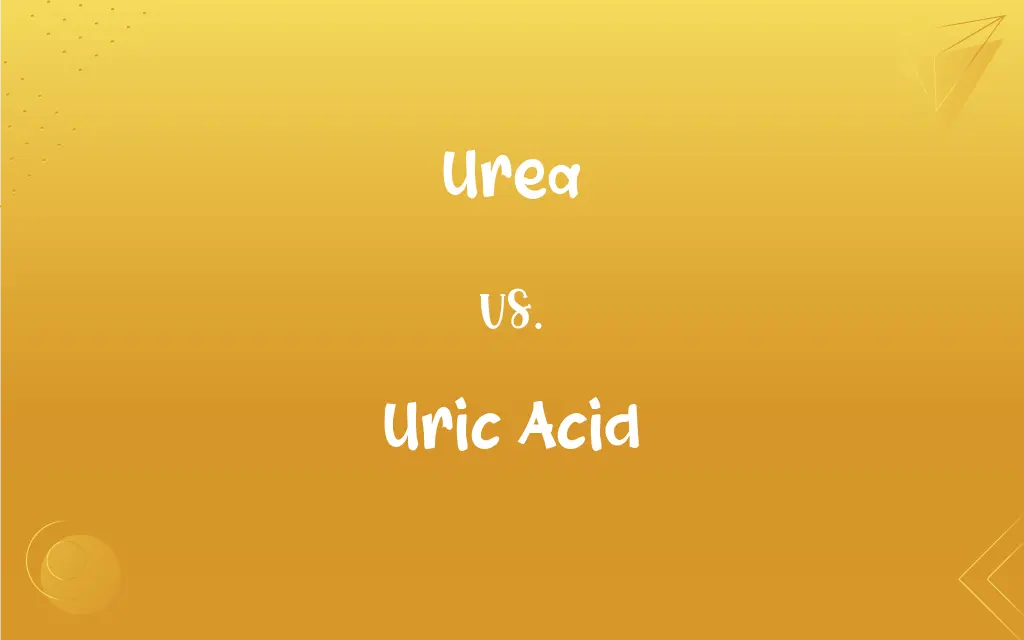Urea vs. Uric Acid: What's the Difference?
Edited by Harlon Moss || By Aimie Carlson || Published on December 6, 2023
Urea is a waste product formed from the breakdown of proteins, commonly excreted in urine, while uric acid is produced from the breakdown of purines and can accumulate in the body, leading to gout.

Key Differences
Urea is formed in the liver as a waste product of protein metabolism and is highly soluble in water. While, uric acid is produced from the metabolism of purines, found in many foods, and is less soluble in water, which can lead to its crystallization in the body.
The human body excretes urea primarily through urine, making it a major component of urine. However, uric acid is also excreted through urine, but its lower solubility can cause it to accumulate in the body, potentially leading to conditions like gout.
Elevated levels of urea in the blood can indicate kidney dysfunction. High levels of uric acid can lead to gout and are associated with other health conditions like kidney stones and renal failure.
Urea serves primarily as a vehicle for nitrogen excretion. Uric acid, apart from being a waste product, also has antioxidant properties.
Urea is used in medical diagnostics, and in various industrial applications, including fertilizers and cosmetics. Uric acid’s significance lies mainly in its medical implications, particularly in diagnosing and managing gout.
ADVERTISEMENT
Comparison Chart
Formation
From protein metabolism.
From purine metabolism.
Excretion
Primarily through urine, highly soluble.
Through urine, less soluble, can accumulate.
Health Implications
Indicator of kidney function.
Can lead to gout, kidney stones.
Biological Role
Nitrogen excretion.
Waste product with antioxidant properties.
Uses
Medical diagnostics, fertilizers, cosmetics.
Medical diagnosis and management of gout.
ADVERTISEMENT
Urea and Uric Acid Definitions
Urea
Used as a fertilizer due to its high nitrogen content.
Urea-based fertilizers are popular in agriculture.
Uric Acid
Excreted through the kidneys and urine.
Kidney function affects uric acid excretion.
Urea
A nitrogen-containing compound produced in the liver.
Urea is synthesized in the liver from ammonia.
Uric Acid
A product of purine metabolism in the body.
Uric acid levels can rise with high purine diets.
Urea
A major organic component of human urine.
Urine analysis often measures urea levels.
Uric Acid
Can crystallize in joints, causing gout.
Elevated uric acid is a primary cause of gout.
Urea
Employed in cosmetics for its moisturizing properties.
This lotion contains urea for better skin hydration.
Uric Acid
Associated with kidney stones and renal failure.
High uric acid levels can lead to kidney stones.
Urea
Utilized in medical diagnostics.
Blood urea nitrogen tests assess kidney function.
Uric Acid
Acts as an antioxidant in the human body.
Uric acid has natural antioxidant properties.
Urea
A water-soluble compound, CO(NH2)2, that is the major nitrogenous end product of protein metabolism and is the chief nitrogenous component of the urine in mammals and certain other animals. Also called carbamide.
Urea
A water-soluble organic compound, CO(NH2)2, formed by the metabolism of proteins and excreted in the urine.
Urea
Any N-substituted derivative of urea, with the general formula (R1R2N)CO(NR3R4).
Urea
A very soluble crystalline body which is the chief constituent of the urine in mammals and some other animals. It is also present in small quantity in blood, serous fluids, lymph, the liver, etc.
Urea
The chief solid component of mammalian urine; synthesized from ammonia and carbon dioxide and used as fertilizer and in animal feed and in plastics
FAQs
What is urea?
A waste product from protein breakdown, excreted in urine.
Where is urea excreted?
Primarily through the kidneys in urine.
How is uric acid formed?
From the breakdown of purines in the body.
How is urea formed?
In the liver from the breakdown of amino acids.
What conditions are associated with high uric acid?
Gout, kidney stones, and renal failure.
How is uric acid excreted?
Through the kidneys, but can accumulate in the body.
What are the health risks of high urea levels?
Indicate potential kidney problems.
What is uric acid?
A byproduct of purine metabolism, potentially causing gout.
Can urea be toxic?
High levels can be toxic and indicate kidney issues.
Is uric acid always harmful?
Not always, but high levels can cause health issues.
What are normal uric acid levels?
Typically 3.4-7.0 mg/dL for men and 2.4-6.0 mg/dL for women.
Does uric acid have any beneficial role?
It acts as an antioxidant.
How can uric acid levels be managed?
With medication and diet low in purines.
What foods increase uric acid?
Red meat, seafood, and alcohol.
Can lifestyle changes reduce uric acid?
Yes, diet and hydration play a significant role.
What are normal urea levels?
Generally, 7-20 mg/dL in blood tests.
Is urea used in agriculture?
Yes, as a nitrogen-rich fertilizer.
How can urea levels be reduced?
Through proper kidney function and hydration.
Is urea present in cosmetics?
Yes, for its moisturizing properties.
Do urea levels affect hydration?
They can indicate hydration levels and kidney function.
About Author
Written by
Aimie CarlsonAimie Carlson, holding a master's degree in English literature, is a fervent English language enthusiast. She lends her writing talents to Difference Wiki, a prominent website that specializes in comparisons, offering readers insightful analyses that both captivate and inform.
Edited by
Harlon MossHarlon is a seasoned quality moderator and accomplished content writer for Difference Wiki. An alumnus of the prestigious University of California, he earned his degree in Computer Science. Leveraging his academic background, Harlon brings a meticulous and informed perspective to his work, ensuring content accuracy and excellence.







































































